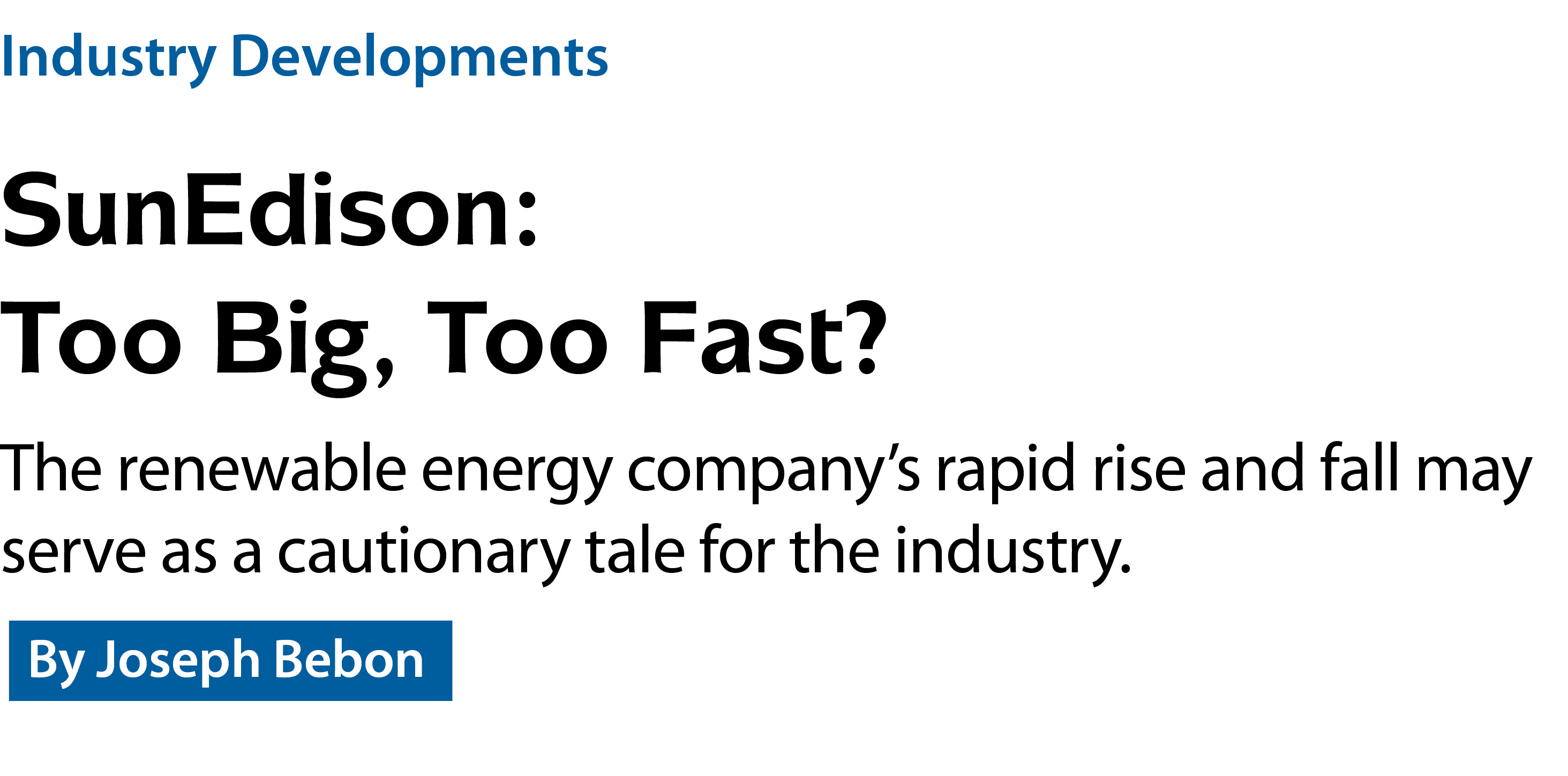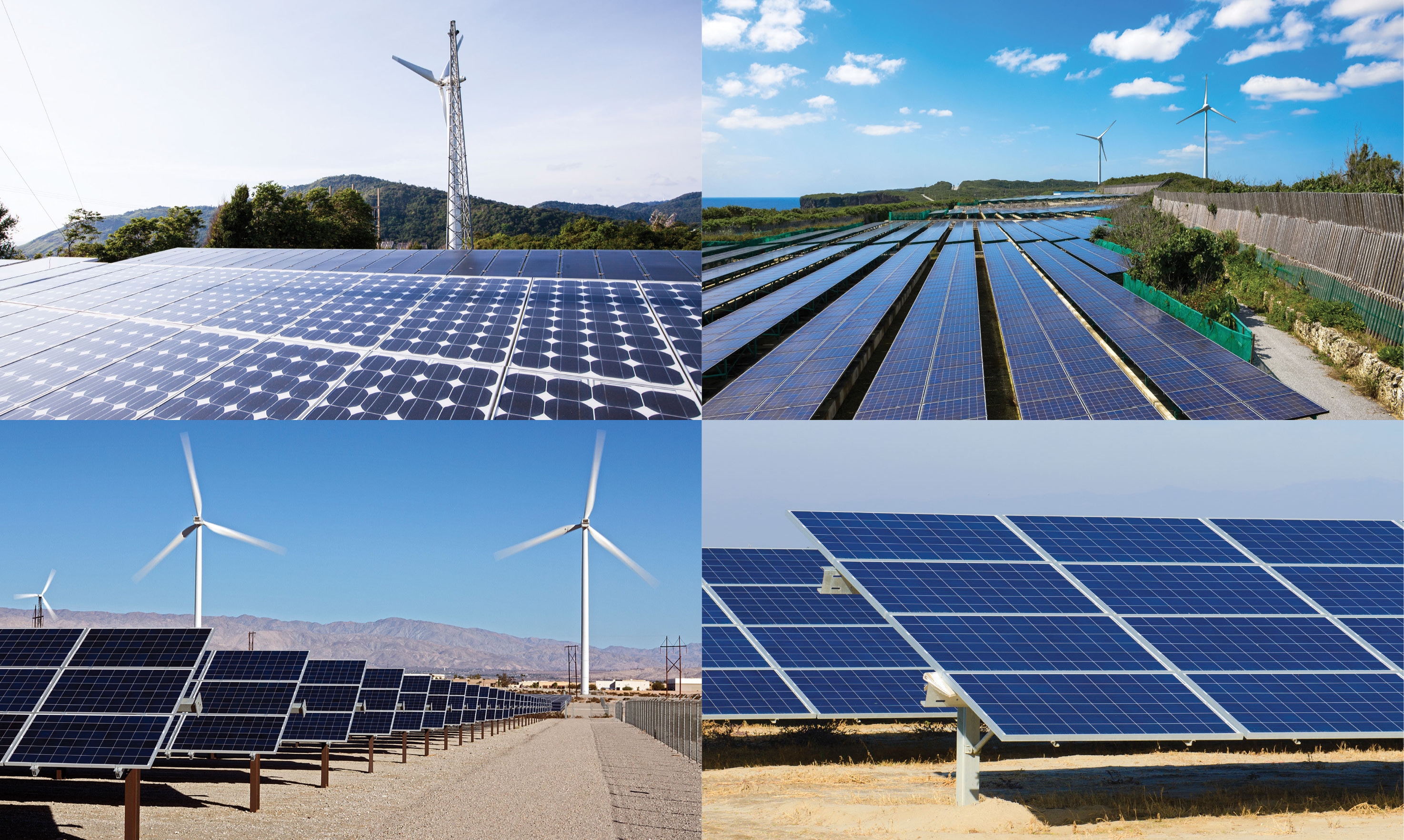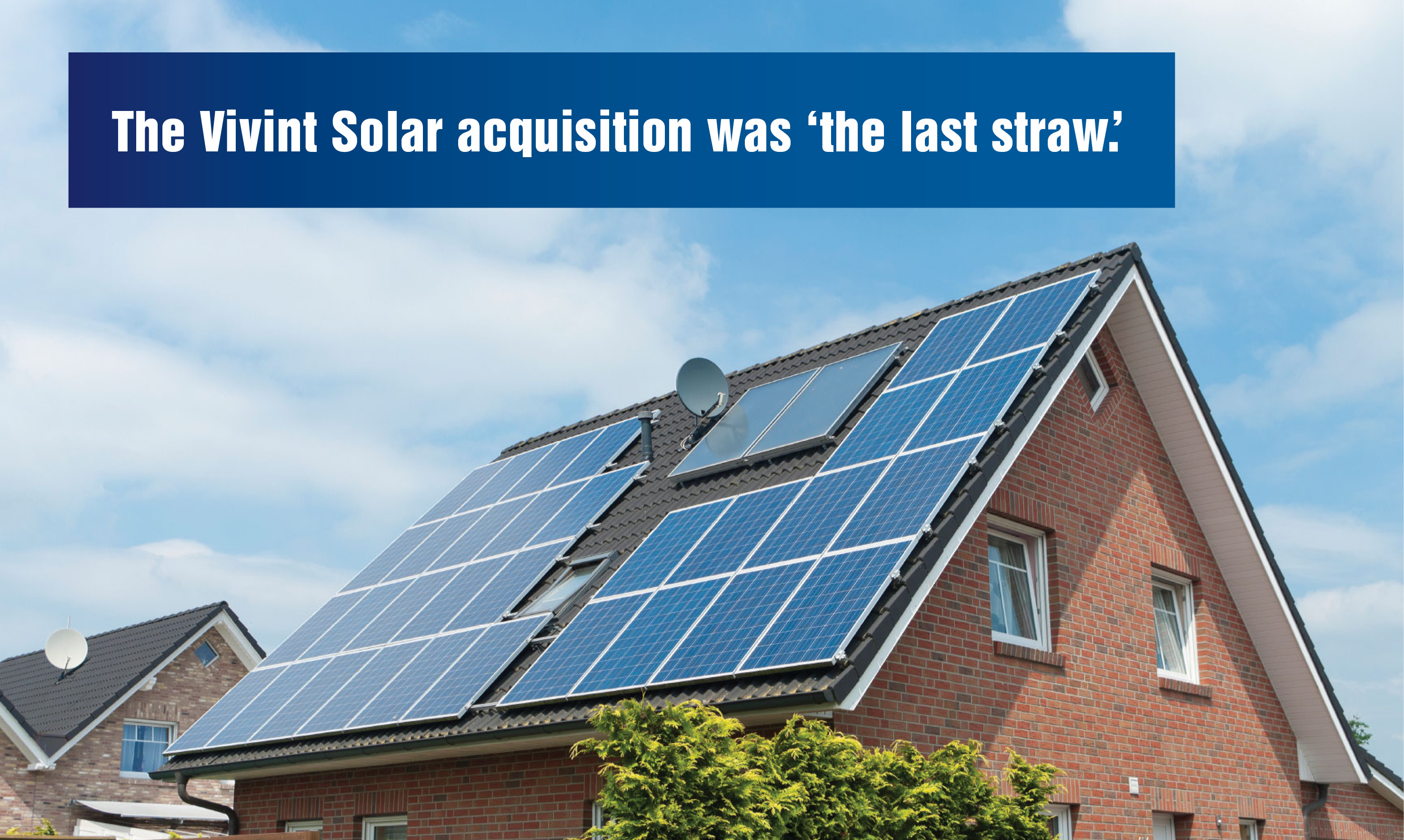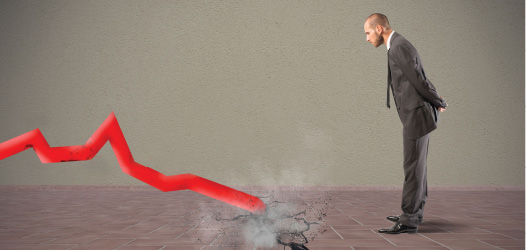

301 Moved Permanently
Once the self-proclaimed “leading renewable power plant developer in the world,” U.S.-based SunEdison filed for Chapter 11 bankruptcy on April 21.
“Our decision to initiate a court-supervised restructuring was a difficult but important step to address our immediate liquidity issues,” explained Ahmad Chatila, CEO of SunEdison, at the time. The bankruptcy announcement came as no surprise, as the company’s troubles - both financial and legal - were well known to the public by then.
In an effort to grow, SunEdison launched two publicly traded yieldcos between 2014 and 2015. The solar company went on a buying spree, entering the wind power space in a big way with the acquisition of developer First Wind for $2.4 billion and expanding its footprint with many other deals across the globe. According to Josefin Berg, a senior analyst at research firm IHS, SunEdison became one of the largest PV developers in the world, ranking second behind Enel Green Power.
However, SunEdison accumulated massive amounts of debt during its meteoric growth. Its stocks started to drop about a year or so ago, and the company revealed plans in February to close, downsize or sell some factories as part of an “asset-light strategy.”
The company was also hit with several lawsuits, including from Vivint Solar for a failed merger agreement and TerraForm Global, its own yieldco, for an alleged “misappropriation of funds.” Before that, SunEdison settled a separate legal challenge with Latin America Power shareholders for $28.5 million following another cancelled acquisition. Further complicating matters, the U.S. Securities and Exchange Commission and the U.S. Department of Justice started investigating SunEdison’s Vivint deal and other financial issues.
Cause and effect
Several market experts suggest extreme ambition was SunEdison’s ultimate downfall. Jenny Chase, Bloomberg New Energy Finance’s head of solar insight, says, “What has distinguished SunEdison has been the relentless and unfocused pursuit of growth, in which it has invested vast amounts of borrowed money. Not all of its ventures succeeded, which is inevitable in the project-development business, but SunEdison’s win-to-loss ratio was evidently insufficient.”
“While some reports have blamed market conditions for the majority of SunEdison’s problems, other analysts blame the firm’s overly ambitious strategy and imprudent financial management,” notes Ryan Moody, North American analyst at MAKE Consulting. “In reality, the trouble stems from a combination of the two: The company’s strategy poorly suited the market environment.
“The wider segments of U.S. yieldcos and solar companies have taken a dive, while debt financing rates have risen,” he says, adding, “Instead of waiting for capital market conditions to improve, the group proceeded to rack up expensive debt while issuing new stock at bargain prices.”
SunEdison, itself, released the results of an internal probe shortly before the bankruptcy filing. Although it determined executives committed no “willful misconduct,” the report said the company “lacked sufficient controls and processes” to handle its cashflow and blamed management’s “overly optimistic culture” for the company’s financial woes.
Raj Prabhu, CEO and co-founder of Mercom Capital Group, says SunEdison made several missteps.

For example, although it’s not uncommon for developers to build both solar and wind projects, Prabhu suggests SunEdison’s acquisition of First Wind, which marked the solar company’s premier wind endeavor, was too big. “Wind development was not SunEdison’s core competency, so paying about $2 billion for its initial wind play was very aggressive,” he says. “It raised a lot of debt - and eyebrows.”
Prabhu says the Vivint Solar acquisition was “the last straw” for SunEdison, even before the merger fell through. “When SunEdison, a large-scale developer, announced plans to buy Vivint, a rooftop solar company, for another $2 billion or so, investors wondered how the deal made strategic sense and stepped back. Rooftop solar is a completely different animal. SunEdison’s stock started to plummet, and the company never recovered after that.”
Berg adds, “Troublesome deals, such as the Vivint Solar intent, didn’t cause the crash but were more a sign that the wheel was spinning too fast.”
SunEdison respectfully declined to comment for this story.
Market shock wave
SunEdison’s two yieldcos, TerraForm Power and TerraForm Global, were not part of the bankruptcy filing, and the companies said in April that they expected to continue operating. Nevertheless, the fall of SunEdison has made some renewable energy stakeholders question the viability of the yieldco structure.
Basically, a yieldco is a public company established to acquire operating renewables projects from its parent company, otherwise known as a sponsor. SunEdison, as the majority stakeholder and sponsor of the TerraForm companies, “drops down” its developed projects into the yieldcos, which then own and operate the assets and collect a steady stream of income from long-term power purchase agreements, a portion of which is paid back to investors as dividends. SunEdison, meanwhile, takes the money paid by its yieldcos and uses it to build more projects.
“The yieldcos weren’t the cause of the troubles, but they helped to fuel what turned out to be unhealthy growth,” says Berg.
Prabhu points out that the yieldco structure is not new. He says, “The model works and has been utilized in the power industry and in Europe for a while now. Once SunEdison started its yieldcos, the market perception was great. They were able to raise a lot of money during the [initial public offerings], but SunEdison started to get a little bit greedy, decided to take advantage of the situation and made a lot of acquisitions. I mean a lot.”
In addition, he says, having two yieldcos meant SunEdison “had to be even more aggressive in order to feed two beasts.” Prabhu notes some other renewable energy yieldcos, such as Pattern Energy, “are much more conservative and so far have not had many problems.”
Moody agrees. “In contrast to SunEdison, most yieldcos have taken a more conservative approach while their stock prices sagged, which is where SunEdison faltered,” he says. “For example, NextEra Energy Partners, with a more moderate dividend growth trajectory than SunEdison, paused plans for new stock offerings during the downturn in the equity market.”
Prabhu says one problem with the yieldco model, though, has been a perceived conflict of interest. “SunEdison might want to sell a project to its yieldco whether the yieldco wants it or not - and at a price that might be above the market value. Who is looking after whom?” Furthermore, SunEdison and its yieldcos shared and swapped management members. “It was kind of like musical chairs,” says Prabhu. “That does not give confidence to the market.”
“Bloomberg New Energy Finance suspects that if yieldcos are to make a return, they will need to have a management team that is not directly affiliated with a developer and which investors trust to serve their interests exclusively,” says Chase.
Prabhu cautions that, although a yieldco is still a viable option, now is likely not the time for a renewable developer to launch one - or to go public, for that matter.
“Investors are not running to yieldcos,” he says. “Even for anybody wanting to become a public solar company on the stock market, it’s not a good atmosphere at the moment. We have a perception problem that SunEdison created and that can negatively affect the rest of the market in the short term.”
However, Chase asserts, “SunEdison’s bankruptcy says more about the company’s strategic decisions than about the solar industry as a whole. Comparable companies SunPower and First Solar have managed a develop-and-sell business profitably over the past three years.”

Dan Whitten, vice president of communications for the Solar Energy Industries Association, has echoed that sentiment.
“This is a highly competitive industry with a massive upside,” he said in an April statement after SunEdison filed for bankruptcy. “As with other rapidly growing and successful industries, not every company in the solar market is going to stand the test of time. SunEdison is just one company, and today’s development does not reflect a trend of the broader industry.”
Prabhu considers SunEdison’s downward spiral a cautionary tale for the rest of the renewables sector.
“SunEdison wanted to become the biggest renewables company in the world, and they could’ve gotten there and stayed there. But not at the pace they went,” he says.
As the industry works to recover from the recent public-perception problem, at press time, it appears SunEdison will continue working to restructure itself.
“Having the Chapter 11 filing on the table starts the process to settle SunEdison’s future,” says Berg. “Questions have piled up regarding SunEdison’s assets, project pipeline and joint ventures across the world. It will take all of 2016 to untangle this giant’s complex business structure.”
Moody thinks SunEdison’s large solar and wind asset portfolio will become a target for acquisition. “In the U.S., the timing of these potential sales is particularly favorable, considering the [production and investment tax credits] have been extended for several years, and utilities and [independent power producers] are looking ahead to renewable electricity standards and Clean Power Plan targets,” he says. “MAKE expects the strong demand for renewable energy in the next few years to fill the void left by diminished growth expectations from SunEdison and the yieldco segment.”
As for the TerraForm yieldcos, Prabhu says, “We’ll see how it works out. Yieldcos need a parent company to drop down projects because they don’t develop their own. Where are the projects going to come from in the future? Is SunEdison going to come out of Chapter 11 and be able to provide them again, or will the yieldcos try to buy third-party projects? Will SunEdison sell its shares in the yieldcos in order to raise cash and get out of its bankruptcy situation? There are many options to be worked out. It’s going to take awhile.”
Despite these recent headwinds, Prabhu still expects strong year-over-year growth in the solar sector in 2016. “We’ve gone through many cycles of ups and downs. The SunEdison situation is not a reflection of the whole market,” he says. “I think the market is going to be just fine.”
Industry Developments
SunEdison: Too Big, Too Fast?
By Joseph Bebon
The renewable energy company’s rapid rise and fall may serve as a cautionary tale for the industry.


si body si body i si body bi si body b
si depbio
- si bullets
si sh
si subhead
pullquote
si first graph
si sh no rule
si last graph